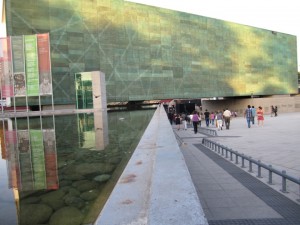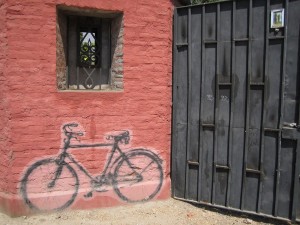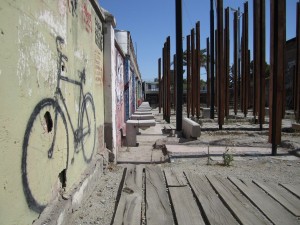Letters from Chile: The working of history at six sites of memory
21 March 2012 – Zachary McKiernan
Bike culture in Santiago de Chile has boomed in recent years, and today bicycles are veritable mainstays throughout the city. The reasons are many: an uptick in Chileans’ environmental consciousness, skyrocketing public transport prices and the slashing of services, and most importantly, according to the folks at Bicicultura, the cultural dissociation between bicycles and poverty. For the first time here, I myself have acquired a bike to join the fray, while memory scholar and political scientist Katherine Hite wrote to me that for the first time in 30 years of coming to Chile, she rode a bike in Santiago just last year.
More importantly, though, Santiago’s bike culture has boomed in another way: in the context of Fernando Traverso’s now transnational bike memorial silhouettes that began in Rosario, Argentina, as a way to remember and mark the absence of that city’s disappeared persons. In Rosario during the dictatorship (1976-1983), bicycles were a main mode of transportation. It wasn’t uncommon to see these human powered machines resting against the sides of walls and buildings and up against city trees. The eerie thing, though, is that an unclaimed bike was the first public sign of the owner’s disappearance. Since then, as Katherine Hite writes convincingly in Politics and the Art of Commemoration (Routledge, 2011, p. 93), “The bici memorials of Traverso both mourn the sacrifice, the failed projects of the past, and establish politically minded global connection, participation, and possibility.”
 It was a powerfully symbolic message, then, that while I visited the six sites of memory in Chile affiliated with the International Coalition of Sites of Conscience, I found Traverso’s bicis helping shape the historical horizon at two of the sites, Villa Grimaldi Park for Peace and Casa José Domingo Cañas 1367. The bicis once were parked and have since been painted over at the National Stadium and the Museum of Memory and Human Rights (pictured at left; Nido 20, and Memorial Paine are the ICSC’s other members in Chile). I had selected these particular sites as part of my dissertation research in order to take the pulse of public history in post-Pinochet Chile. Given that these six sites are, at least in theory, examples of how historic sites can engage citizens in human rights issues, practitioners of history here find themselves in important and simultaneously precarious personal and political positions. In turn, I tried to begin with two seemingly simple questions while visiting these very similar yet markedly different public places: What type of historic working is taking place? And who is doing that work?
It was a powerfully symbolic message, then, that while I visited the six sites of memory in Chile affiliated with the International Coalition of Sites of Conscience, I found Traverso’s bicis helping shape the historical horizon at two of the sites, Villa Grimaldi Park for Peace and Casa José Domingo Cañas 1367. The bicis once were parked and have since been painted over at the National Stadium and the Museum of Memory and Human Rights (pictured at left; Nido 20, and Memorial Paine are the ICSC’s other members in Chile). I had selected these particular sites as part of my dissertation research in order to take the pulse of public history in post-Pinochet Chile. Given that these six sites are, at least in theory, examples of how historic sites can engage citizens in human rights issues, practitioners of history here find themselves in important and simultaneously precarious personal and political positions. In turn, I tried to begin with two seemingly simple questions while visiting these very similar yet markedly different public places: What type of historic working is taking place? And who is doing that work?
Finding the answers to these questions opens analysis into how Chile and other societies deal with disputed pasts. So too does it allow us to reflect on and question the importance of history as a problem-solving and community-building discipline in the present and public sphere. When the ICSC was established in 1999, the diverse array of directors adopted the statement “that it is the obligation of historic sites to assist the public in drawing connections between the history of our sites and its contemporary implications. We view stimulating dialogue on pressing social issues and promoting democratic and humanitarian values as a primary function” (The Public Historian, February 2008, Vol. 30). This obligation and primary function has since matured into a call of “from memory to action,” and I believe that unique ways of thinking about public history and human rights activism can be had by bringing together the two to memorialize and re-valorize historic sites associated with trauma and violence.
These ways of thinking also open up unique strategies of “history exhibit practice in an age of ubiquitous display,” the goal of NCPH’s “Off the Wall” exhibit review project. They force us to consider the special contingencies that connect the sites that I review in this series: physical places and (sometimes erased) remnants of Pinochet’s wrath, sites whose histories are painful to navigate but necessary to recover and re-tell. Too, given that these sites sprang from grassroots human rights initiatives based in a moral conviction to challenge the political and legal status quo, our urgent attention is drawn towards the truth expressed by Felipe Aguero, a one-time prisoner at the National Stadium and now a political scientist: “Democratic transitions… could not be considered completed unless claims from the victims of atrocities were adequately addressed” (Radical History Review No. 97, Winter 2007). In many ways, then, the continued struggle to recover these sites and the perpetual skirmish for recognition, legitimacy, and funding are claims that contest Chile’s tightly constructed transition narrative through the reminder that demands still exist from victims and their allies. As the directors of Nido 20 told me more bluntly at the community center attached to the small suburban house which once served as a clandestine torture and extermination site, “The transition is not complete.”
“Letters from Chile” is an exercise to review the interpretive strategies and historic work at six Chilean sites of memory, sites that represent a recent trend where “historic sites… have become critical elements in current struggles for human rights and democracy” (“Memorialization and Democracy: State Policy and Civic Action” conference Santiago, 2007). The series also represents an opportunity to share with a new audience the historic-activism happening at the end of the world–and maybe the tip of an iceberg in a still undefined field of Chilean public history. So as I ride my red bike around Santiago’s Gran Avenidas and smaller streets to investigate the spaces that have opened for Chile’s other bike culture–Traverso’s–I invite those both familiar and unfamiliar with the Chilean case along for a sometimes bumpy yet necessary ride to “establish politically minded global connection, participation, and possibility.”
~ Zachary McKiernan
[NOTE: This is the introductory post of a series that began last week with An Urgent Call to Action in Aysén, Chile, which was posted first for reasons of timeliness.]






Zach,
So good to read about your work in Chile – look forward to future installations!
Best wishes,
Julia